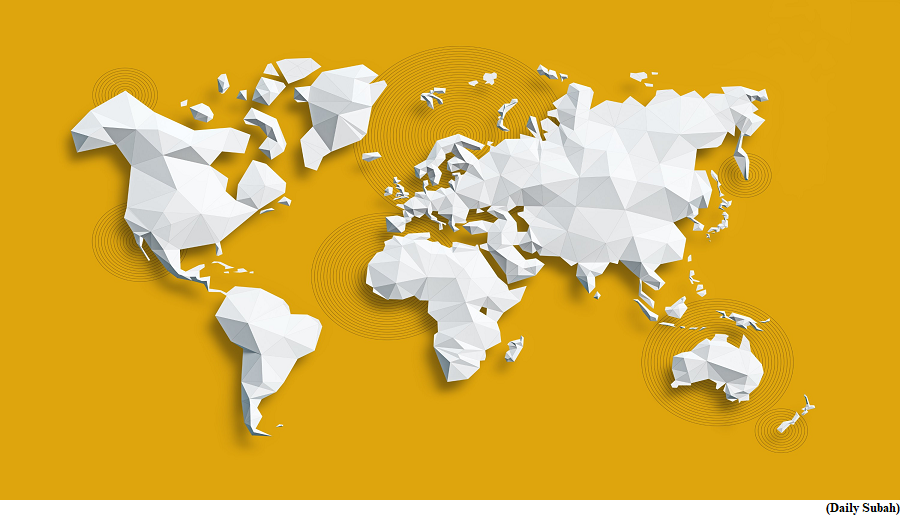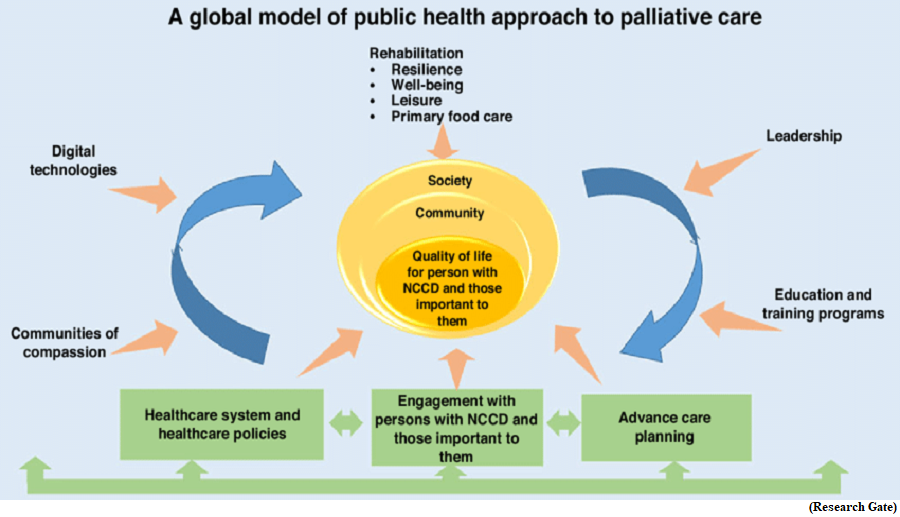The Global South, origins and significance (GS Paper 2, International Relation)

Why in news?
- The unwillingness of many leading countries in Africa, Asia and Latin America to stand with NATO over the war in Ukraine has brought to the fore once again the term “Global South.”
What is Global South?
- The Global South refers to various countries around the world that are sometimes described as ‘developing’, ‘less developed’ or ‘underdeveloped’.
- Many of these countries are in the Southern Hemisphere, largely in Africa, Asia and Latin America.
- In general, they are poorer, have higher levels of income inequality and suffer lower life expectancy and harsher living conditions than countries in the “Global North” , that is, richer nations that are located mostly in North America and Europe, with some additions in Oceania and elsewhere.
- The term Global South appears to have been first used in 1969 by political activist Carl Oglesby. Writing in the liberal Catholic magazine Commonweal, he argued that the war in Vietnam was the culmination of a history of northern “dominance over the global south.”
The term during Cold War era:
- But it was only after the 1991 breakup of the Soviet Union that the term gained momentum. Until then, the more common term for developing nations was ‘Third World’.
- That term was coined by Alfred Sauvy in 1952, in an analogy with France’s historical three estates: the nobility, the clergy and the bourgeoisie.
- The term ‘First World’ referred to the advanced capitalist nations; the ‘Second World’, to the socialist nations led by the Soviet Union; and the ‘Third World’, to developing nations, many at the time still under the colonial yoke.
- Sociologist Peter Worsley’s 1964 book, ‘The Third World: A Vital New Force’ in International Affairs, further popularised the term.
- ‘Third World’ became a synonym for banana republics ruled by tinpot dictators, a caricature spread by Western media.
- The fall of the Soviet Union gave a convenient pretext for the term ‘Third World’ to disappear, too. Usage of the term fell rapidly in the 1990s.
Geopolitical term:
- The term ‘Global South’ is not geographical. In fact, the Global South’s two largest countries, China and India lie entirely in the Northern Hemisphere. Rather, its usage denotes a mix of political, geopolitical and economic commonalities between nations.
- Countries in the Global South were mostly at the receiving end of imperialism and colonial rule, with African countries as perhaps the most visible example of this.
- Since the turn of the 21st century, a “shift in wealth,” as the World Bank has referred to it, from the North Atlantic to Asia Pacific has upended much of the conventional wisdom on where the world’s riches are being generated.
- By 2030 it is projected that three of the four largest economies will be from the Global South — with the order being China, India, the U.S. and Indonesia. Already the GDP in terms of purchasing power of the the Global South-dominated BRICS nations — Brazil, Russia, India, China and South Africa surpasses that of the Global North’s G-7 club.
The need for strengthening palliative care in the face of non communicable diseases
(GS Paper 2, Health)
Context:
- India is home to nearly 20% of the world’s population, two-thirds of which reside in rural areas. Apart from a rising population, India has experienced a steep rise in the burden of lifestyle-related non-communicable diseases.
- Nearly 1.4 million people are diagnosed with cancer in India every year while diabetes, hypertension, and respiratory diseases are also on the rise. All these diseases need palliative care sooner or later in the disease trajectory.

What is palliative care?
- Palliative care is the branch of medicine focusing on improving the quality of life and preventing suffering among those with life-limiting illnesses. It aims to identify patients at risk of over-medicalisation at the expense of quality of life and financial burden on the family.
- It is often misinterpreted as end-of-life care. However, palliative care aims to improve the quality of life by addressing the physical, psychological, spiritual, and social domains of the health of people suffering from life-limiting diseases like heart failure, kidney failure, certain neurological diseases, cancer, etc.
How many need palliative care?
- Palliative care in India has largely been available at tertiary healthcare facilities in urban areas. Due to skewed availability of services, it is accessible to only 1-2% of the estimated 7-10 million people who require it in the country.
- A three-tier health system, multiple national health programmes and schemes, and the Ayushman Bharat Health Insurance Scheme are all positive steps taken towards universal health coverage.
- However, despite these efforts, 55 million people in India are pushed below the poverty line every year due to health-related expenditures. Over-medicalisation plays a significant role in this financial burden.
Is there a palliative care programme?
- The National Programme for Prevention & Control of Cancer, Diabetes, Cardiovascular Diseases & Stroke (NPCDCS), now the National Programme for Prevention & Control of Non-Communicable Diseases (NP-NCD), includes chronic diseases whose treatment contributes the most to health-related expenses. These diseases progress to a stage where, in an ideal scenario, palliative care should take over curative care.
- Launched in 2010 to counter the rising burden of non-communicable diseases in the country, the programme envisaged the provision of promotive, preventive, and curative care from primary to tertiary institutes, thus providing health services delivery across the continuum of care.
- The revised operational guidelines of NP-NCD were expected to strengthen the programme. However, it has not succeeded in addressing certain gaps in palliative care in India.
What are the gaps in the guidelines?
- As per the Global Atlas of Palliative Care, in 2020, the need for palliative care was higher for non-cancer illnesses. However, the revised NP-NCD operational guidelines, released in May 2023, mention palliative care in synonymy with just cancer. This is a step back from the previous operational guideline, in which chronic and debilitating conditions also fell under the ambit of palliative care.
- Since most patients who need palliative care are suffering from debilitating diseases, home-based care forms the ideal mode of healthcare delivery.
- Previously, the programme guidelines mentioned support being provided to facilitate home-based palliative care services. However, palliative care service delivery starts only from the district hospital in the revised guidelines, with no mention of home-based care.
- The guidelines mention the linking of 11 programmes to promote the convergence of services focusing on the care of non-communicable diseases.
- One of these is the National Programme for Palliative Care (NPPC). NPPC was announced in 2012; however, the lack of a dedicated budget has prevented the implementation of the programme since its inception. Experiences from the field suggest that many medical officers at primary health centres are not aware of the existence of such a programme.
How is such access measured?
- The guidelines’ narrow focus is also evident from the indicator chosen to assess the programme’s impact. Access to palliative care will be assessed by estimating morphine-equivalent consumption of strong opioid analgesics (excluding methadone) per death from cancer.
- The World Health Organization recommends the use of morphine consumption per capita to assess morphine access for palliative care services. Using this indicator would also have allowed us to compare the progress of palliative care services in India with other countries.
- The 67th World Health Assembly in 2014 called for palliative care to be integrated into health systems at all levels.
Article 370, What is it, why was it abrogated and who is challenging it now?
(GS Paper 2, Governance)
Why in news?
- Nearly four years after the abrogation of Article 370, the Supreme Court (SC) has issued a notice that it will hear a batch of petitions challenging the decision made by the government in 2019 on a day-to-day basis starting August 2.
- Chief Justice of India (CJI) D Y Chandrachud will head the Constitution bench.
- The cause is titled: Shah Faesal and Others vs Union of India and Another.

What is Article 370?
- Article 370 was a key provision in the Indian Constitution that granted special status to the former state of Jammu and Kashmir. In March 1948, the then Maharaja of Kashmir, Hari Singh had, appointed an interim government in the state, with Sheikh Abdullah as prime minister.
- In July 1949, Sheikh Abdullah and three other colleagues joined the Indian Constituent Assembly and subsequently negotiated the special status of Jammu and Kashmir. This led to the adoption of Article 370, which was enacted in the same year.
- It provided some autonomy to Jammu and Kashmir, such as allowing the state to have its own constitution, a separate flag, and limited jurisdiction for the Indian government.
- There was a provision in the article under Article 370(1)(c) stating that Article 1 of the Indian Constitution applies to Kashmir through Article 370. Article 1 lists the states of the Union. This means that it is Article 370 that binds the state of Jammu & Kashmir to the Indian Union.
- Although Article 370 can be removed through a Presidential Order, it would render the state independent of India unless new overriding laws were made.
Abrogation of Article 370:
- On August 5, 2019, the government of India, decided to abrogate Article 370, Jammu and Kashmir's special status, through a presidential order.
- This move was accompanied by a proposal to bifurcate the state of Jammu and Kashmir into two separate Union Territories: Jammu and Kashmir and Ladakh.
- The Union Territory of Jammu and Kashmir would have a legislature, while Ladakh would be without one. The abrogation of Article 370 and the reorganisation of Jammu and Kashmir into Union Territories took effect on October 31, 2019.
- Since then, the region has witnessed significant changes in governance, administration, and socio-political dynamics. The full implications and consequences of the abrogation are still evolving, and its impact on the region continues to be a subject of debate and discussion.
Why did the government decide to abrogate Article 370?
- The decision to abrogate Article 370 was based on the government's belief that it hindered the integration of Jammu and Kashmir with the rest of India and limited the region's development.
- Supporters of the abrogation argued that it would help bring socio-economic development, promote equal rights and opportunities, and ensure better governance in the region.
- They also contended that it would facilitate the application of national laws and programs, which were previously not fully applicable in Jammu and Kashmir.
- Critics of the abrogation raised concerns about the decision's impact on the special status and identity of Jammu and Kashmir, as well as its potential implications for the region's autonomy and demographic composition.
- There were debates about the constitutional validity of the move, with legal challenges brought before the SC.
What’s next?
- A five-judge Constitution bench headed by Chief Justice of India (CJI) is scheduled to hear the case. It will take care of the preliminaries issuing directions over document and written submission filing.




